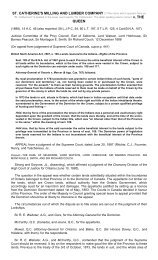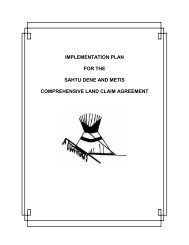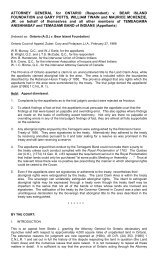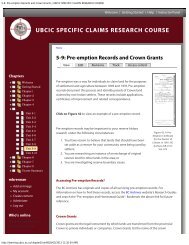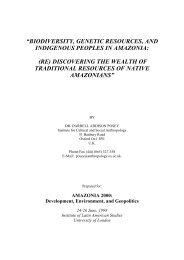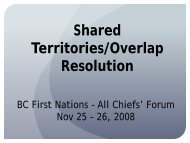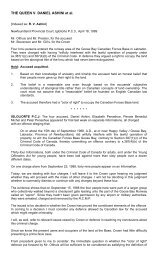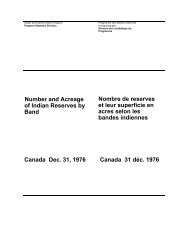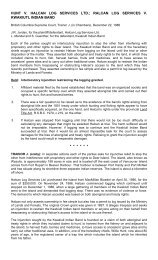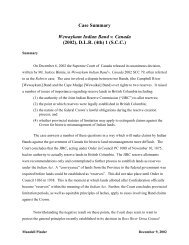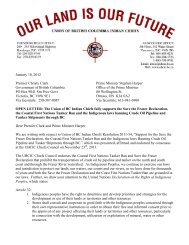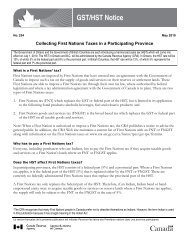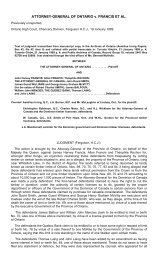Constitutional âPropertyâ and Reserve Creation: Seybold Revisited
Constitutional âPropertyâ and Reserve Creation: Seybold Revisited
Constitutional âPropertyâ and Reserve Creation: Seybold Revisited
You also want an ePaper? Increase the reach of your titles
YUMPU automatically turns print PDFs into web optimized ePapers that Google loves.
18 MANITOBA LAW JOURNAL VOL 32 NO 1tion power in s. 91(24). There would appear to be no limit to the provincial veto.This is an important issue because provinces have demonstrated an unwillingnessto offer up resource-rich Crown l<strong>and</strong> in settlements for Indians. 58 Sometimesthis is an unwillingness to uphold or implement past confirmation agreements,<strong>and</strong> sometimes this is an unwillingness to exp<strong>and</strong> those agreements ascircumstances change. As Michael Ignatieff once said, “we should cease believingthat constitutional settlements will end historical arguments. In reality, they canonly produce a new basis for ongoing <strong>and</strong> unending dialogue.” 59 While it is constitutionallypossible to transfer the administration of l<strong>and</strong> to the federal governmentvoluntarily, this is really anachronistic <strong>and</strong> contrary to the purpose of s.109 <strong>and</strong> its intent.2. Wewaykum <strong>and</strong> confirming provincial reservesIn Wewaykum v. Canada, 60 Binnie J., for the majority of the Supreme Court ofCanada, discussed the issue of reserve confirmation in British Columbia. In theBritish Columbia Terms of Union, 61 British Columbia agreed to convey tracts ofl<strong>and</strong> to the federal government from time to time for Indian reserves. 62 As BinnieJ. described in Wewaykum, henceforth the two governments were largely unableto agree to what l<strong>and</strong>s could be conveyed. Binnie J. examined an inaccurateprovincial Order in Council purporting to convey a reserve to the wrong b<strong>and</strong>.He wrote:We really do not know what intent, if any, the provincial government had. The permissibleconstitutional scope of the provincial “intent” in relation to “L<strong>and</strong>s reserved forIndians” was limited to the size, number <strong>and</strong> location of reserves to be transferred by itto the administration <strong>and</strong> control of the Crown in right of Canada. 63In so putting the answer, Justice Binnie chose to use what is an astonishingly expansiveapproach to provincial competence over s. 109 l<strong>and</strong>s. It is highly questionablethat s. 109 entitles the province to any powers in relation to Indianre-585960616263It is constitutionally possible to “transfer” l<strong>and</strong>s from one jurisdiction to the other. See Higbie,supra note 8, per Rinfret C.J.C.: “After all, there is no real conveyance of property, sinceHis Majesty the King remains the owner in either case <strong>and</strong>, therefore, it is only the administrationof the property which passes...”.Michael Ignatieff, The Rights Revolution (Toronto: House of Anasasi Press, 2000) at 136.[2002] 4 S.C.R. 245, 2002 SCC 79 (QL) [Wewaykum cited to S.C.R.].British Columbia was admitted into the Union pursuant to section 146 of the ConstitutionAct, 1867, 30-31 Vict., c. 3 (U.K.) by the British Columbia Terms of Union, being Order inCouncil of May 16, 1871, effective July 20, 1871.Similar provisions are included in the Constitution Act, 1930, 20-21 Geo. V, c. 26 (U.K.).Wewaykum, supra note 60 at para.70 (Binnie J.).



